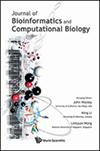系统发育中重建祖先基因组的单倍体染色体补体。
IF 0.9
4区 生物学
Q4 MATHEMATICAL & COMPUTATIONAL BIOLOGY
Journal of Bioinformatics and Computational Biology
Pub Date : 2021-12-01
Epub Date: 2021-11-19
DOI:10.1142/S0219720021400084
引用次数: 0
摘要
利用RACCROCHE方法,从以染色体上的基因顺序为代表的现存基因组的系统发育中重建祖先染色体的基因含量和顺序,研究了木本植物3目的进化。该方法检索系统发育中每个祖先的单倍体补体,包括一套完整的不同染色体,尽管一些现存的基因组最近或历史上被多倍体化。这三个目是Sapindales, Fagales和Malvales。所有这些都被独立地估计为具有祖先的单倍体数[公式:见文本]。本文章由计算机程序翻译,如有差异,请以英文原文为准。
The monoploid chromosome complement of reconstructed ancestral genomes in a phylogeny.
Using RACCROCHE, a method for reconstructing gene content and order of ancestral chromosomes from a phylogeny of extant genomes represented by the gene orders on their chromosomes, we study the evolution of three orders of woody plants. The method retrieves the monoploid complement of each Ancestor in a phylogeny, consisting a complete set of distinct chromosomes, despite some of the extant genomes being recently or historically polyploidized. The three orders are the Sapindales, the Fagales and the Malvales. All of these are independently estimated to have ancestral monoploid number [Formula: see text].
求助全文
通过发布文献求助,成功后即可免费获取论文全文。
去求助
来源期刊

Journal of Bioinformatics and Computational Biology
MATHEMATICAL & COMPUTATIONAL BIOLOGY-
CiteScore
2.10
自引率
0.00%
发文量
57
期刊介绍:
The Journal of Bioinformatics and Computational Biology aims to publish high quality, original research articles, expository tutorial papers and review papers as well as short, critical comments on technical issues associated with the analysis of cellular information.
The research papers will be technical presentations of new assertions, discoveries and tools, intended for a narrower specialist community. The tutorials, reviews and critical commentary will be targeted at a broader readership of biologists who are interested in using computers but are not knowledgeable about scientific computing, and equally, computer scientists who have an interest in biology but are not familiar with current thrusts nor the language of biology. Such carefully chosen tutorials and articles should greatly accelerate the rate of entry of these new creative scientists into the field.
 求助内容:
求助内容: 应助结果提醒方式:
应助结果提醒方式:


